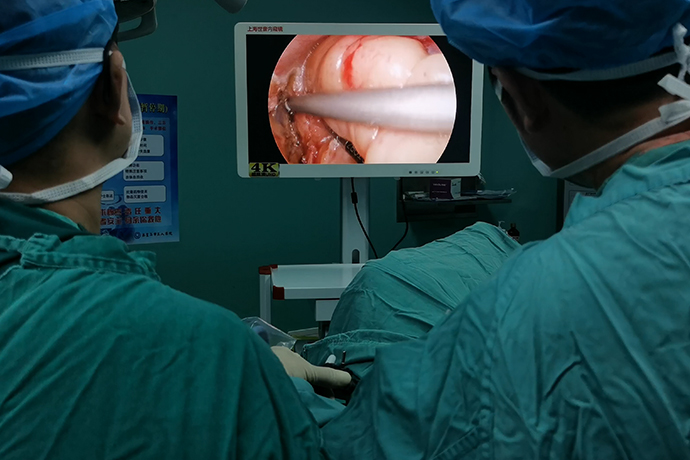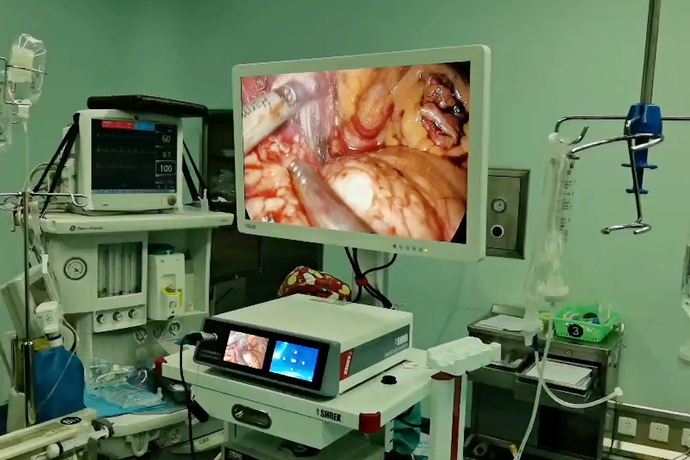[General Surgery Laparoscopy] 4K ultra-high definition laparoscopic radical resection of low rectal cancer
Release time: 23 Apr 2024 Author:Shrek
What is low rectal cancer?
There is currently no precise definition of low rectal cancer. The anal canal is approximately 2 cm long in male anatomy and approximately 1.5 cm in female anatomy. The length of the rectum is 12 to 15 cm and can be divided into upper, middle and lower parts. Therefore, low rectal cancer is usually defined as rectal cancer less than 5 cm from the anal verge or less than 3 cm from the anorectal junction.

The closer the tumor is to the anus, the more difficult it is to preserve the anus. Due to the narrow pelvic cavity, complex anatomical relationships, extremely small surgical field of view, and difficult resection operations, in order to take into account both radical resection and anus preservation, good high-definition laparoscopic equipment and superb surgical techniques are required. Otherwise, either If the tumor is not completely removed, or the anus cannot be saved, all previous efforts will be wasted.
Routine surgery for low rectal cancer: Miles, local excision
Missing anus and permanent stoma have serious consequences for patients
Whether at home or abroad, patients have a strong and widespread demand for anal preservation, and there are profound social and even religious reasons behind this. For the sake of oncological safety alone, overemphasis on the principle of radical oncology during anal resection has caused more and more attention to be paid to the functional loss and psychological burden on patients. Many patients commit suicide after Miles surgery because they cannot accept the fact that they have lost their anus. Missing anus and permanent stoma cause huge physical and psychological trauma to patients, and stoma surgery has more than 20 complications. For patients with low rectal cancer, it is undoubtedly best to choose anus-preserving surgery without affecting the survival outcome. s Choice.
Give full play to the existing advantages of 4K ultra-high definition laparoscopy and strive to help patients "live with dignity"
4K ultra-high definition laparoscopic conformal sphincter preserving operation (CSPO) for low rectal cancer - (NOSES I type G method). This is a surgery that combines total mesorectal excision (TME), anal anastomosis, eversion drag resection, anal canal anatomical dissection, local tumor resection, and natural orifice specimen extraction surgery. NOSES) and other new low-position anus-preserving surgery. Conformal sphincter preserving operation (CSPO) for low rectal cancer is a modified intersphincteric resection (ISR) for low rectal cancer, which can achieve extreme anus preservation for ultra-low rectal cancer while maximizing Preserve anal function. Conformal sphincter preserving operation (CSPO) for low rectal cancer meets the patients’ greatest expectations: cure, minimal trauma, and no permanent stoma.
What’s innovative about CSPO?
(1) CSPO abdominal operation is recommended to preserve the left colic artery around the rectum in the order of "posterior-anterior-lateral-lateral" and dissociate the anterior wall to the level of the tooth line, cut off the Hiatal ligament posteriorly, and dissociate both sides to the level of the anal muscle hiatus. (2) Under direct vision, incise the intestinal tube at the distal end of the tumor, and design the resection line obliquely upward according to the shape of the tumor, so that the normal intestinal tube on the opposite side of the tumor can be preserved to the maximum extent. (3) Cut and suture the retained intestine, and perform anastomosis on the side of the more retained intestine to keep the anastomosis line as far away from the dentate line as possible. (4) The tumor is removed from the anus through the rectal cavity, forming a distal dissection line at least 1cm below the lower edge of the tumor, leaving more of the rectum opposite the tumor.
The difference between CSPO and ISR
(1) Different scopes of surgical resection
It should be pointed out that with the continuous improvement of medical technology and treatment level, the indications for CSPO are also constantly expanding. For example, in locally advanced ultra-low rectal cancer, after preoperative neoadjuvant treatment, the tumor has been significantly downstaged or even reached Patients with complete clinical remission can also undergo CSPO surgery selectively.
A patient suffered from anal distension, gradually thinned stools with pus and blood, and was in great pain. The examination revealed that it was a low-lying rectal cancer. The lower edge of the tumor was about 5cm from the anal edge. The tumor was large and had symptoms of incomplete intestinal obstruction.
Traditional surgery generally adheres to the principle of "life first, function second" to remove the rectum and anus together, but the cost is that the patient becomes an "ostomy person", which seriously affects the future quality of life. In order to better help patients, after preoperative case discussion in the department, it was decided to use the latest 4K laparoscopic equipment and precise surgery to achieve the goal of radical tumor resection while maximizing anus preservation.
4K means that the laparoscope has ultra-high-definition physical resolution, and the clarity is four times that of the original full-HD laparoscope. The biggest feature is that the surgical field of view is expanded and clearer. For doctors, the better the exposure and the clearer the view, the better it is for the operation. A clearer field of view can be obtained during surgery, and tiny blood vessels, tiny nerves, fascia and lymphoid tissue can be displayed more clearly, allowing doctors to perform more detailed and precise surgical operations, avoid damaging nerves and blood vessels, and reduce intraoperative bleeding. etc., it is also conducive to more thorough lymphatic clearance. In addition, extreme high-definition laparoscopy can not only improve the efficiency and success rate of surgery to a greater extent, but also further reduce the occurrence of postoperative complications.
Performing surgery is like watching a "blockbuster", and 4K laparoscopy helps with difficult surgeries. The process of 4K laparoscopic minimally invasive surgery is similar to that of ordinary laparoscopic surgery. But the difference is that a 55-inch display screen is prepared for 4K laparoscopic surgery, which can clearly transmit the images observed by laparoscopy to the screen in real time. The super-large visual effect is equivalent to naked-eye 3D. Every cutting action of the surgeon, changes in the patient's blood vessels and tissues, even a capillary and thin fascia can be clearly displayed. It's like watching a "blockbuster" movie, every detail and close-up in the picture is like being there.
The intestinal adhesions were separated, the tumor site was located, and the total mesorectal resection of the rectal tumor was completed. The intestinal anastomosis was performed to preserve the anus. Through 4K laparoscopic minimally invasive technology, the patient's operation was successful. It ensured that the tumor was completely removed without any residue, and at the same time, it exceeded the limit and preserved the anal function. .
Conformal resection (CSPO) of low rectal cancer achieves the minimally invasive approach
(1) Miles surgery
(2) NOSES I formula G method CSPO method
Compared with traditional Miles surgery, conformal resection and anus-preserving surgery (CSPO) for low rectal cancer can radically remove the tumor while preserving the anus and anal function. It has less trauma, no incision in the abdominal wall, and good abdominal wall cosmetology. It is an indispensable option for patients with low rectal cancer. Two surgical options.

- Recommended news
- 【General Surgery Laparoscopy】Cholecystectomy
- Surgery Steps of Hysteroscopy for Intrauterine Adhesion
- [Gynecological Hysteroscopy] Techniques for Preventing and Treating Complications of Hysteroscopic Surgery
- [Gynecological Hysteroscopy] Hysteroscopic Adhesiolysis
- [Gynecological Hysteroscopy] IUD Removal under Hysteroscopy